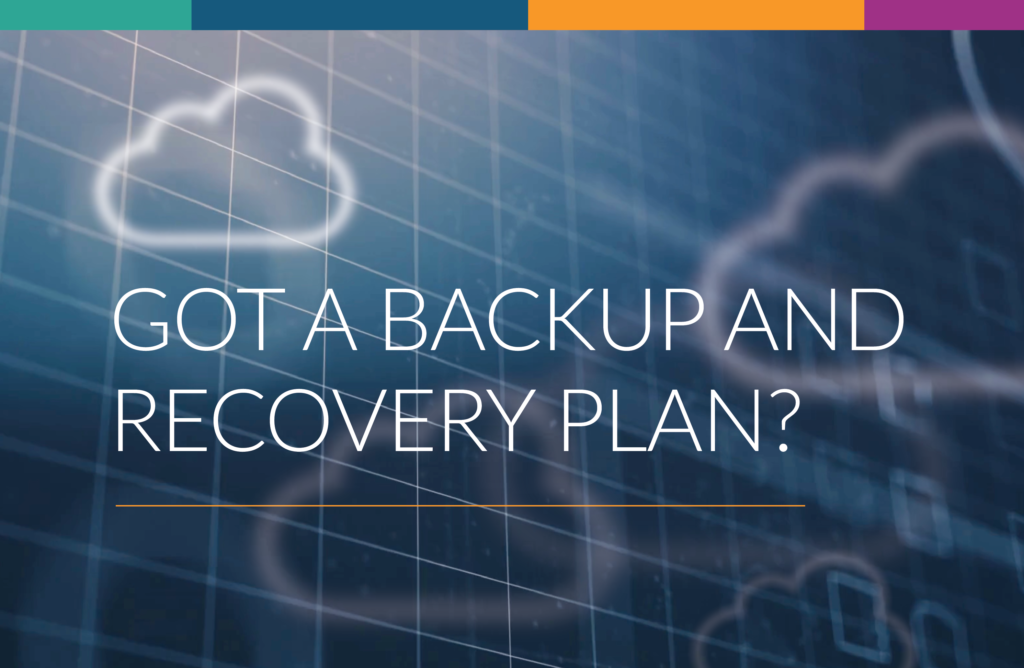“March 31st was World Backup Day… Although you can’t back up time, you can back up your systems, and there is almost nothing more important for your school or business.” – Brian Hess, Spera Partners President
Many organizations are backing up their data but know there is probably more to it. Sound familiar? Find yourself too busy and just keep winging it?
These statistics might prompt you to dig deeper…. Researchers report that 94% of companies that experience severe data loss do not recover and 51% of these companies close within two years of the data loss. They needed a plan in place….do you?
In this blog, we will cover what a Backup and Recovery Plan is (and is not), the 4 key steps to implementing it, and finally, who should create it and why.
What It’s Not
A Backup and Recovery Plan is often mistakenly confused with a Business Continuity Plan (BCP). Organizations hear ‘continuity’ and think technology, then assume they can hand it off to the “computer people.”
A Backup and Recovery Plan is only part of a Business Continuity Plan – not the Business Continuity Plan.
A Business Continuity Plan is a comprehensive plan that outlines the procedures and protocols an organization must follow to ensure that essential business functions can continue to operate during and after a disruptive event. Typically spearheaded by the executive team, a BCP becomes the responsibility of the entire organization. Departments from Operations to Finance to HR should be involved, particularly for critical communications and training.
A fuller description of a BCP can be found here.
IT’s responsibility is to keep employees up and running at all times – especially during an event. This is where the Backup and Recovery Plan comes in.
What It Is
A Backup and Recovery Plan is more than a thumb drive or onsite server (which we wouldn’t recommend by the way). The primary purpose of a BRP is to ensure that critical business data and systems are protected and recoverable in the event of an unexpected disruption – such as a malware attack or environmental disaster.
Even if you know backups are happening ….
- Are they being stored offsite?
- Is your cloud data being backed up too?
- Are you verifying them?
A backup plan will ensure that you are safely and securely doing all of the above, but none of that will matter if you don’t also have a recovery procedure in place and test it periodically.
Here are 4 key steps to a Backup and Recovery Plan:
- Identify critical data and systems: The first step is to identify the data and systems that are critical to your organization’s operations. This includes financial data, customer information, intellectual property, and other essential information.
- Determine backup and recovery solutions: Based on the criticality of the data and systems, determine the appropriate backup and recovery solutions. We recommend an offsite backup (using unique authentication), cloud-based backup, or a combination of these solutions.
- Establish backup and recovery procedures: Clear procedures should be in place for backing up data and systems, as well as for recovering from a disruption. This includes defining the frequency of backups, establishing recovery time objectives (RTOs) and recovery point objectives (RPOs), and identifying the roles and responsibilities of your staff during a recovery.
- Test the backup and recovery plan: Testing or verification is essential to ensure that your Backup and Recovery Plan is effective. Regular tests should be conducted to validate the plan, identify any weaknesses or gaps, and make any necessary adjustments. We would recommend, at a minimum, testing annually.
Other important considerations for a Backup and Recovery Plan include:
- Data security: Ensure that your backup data is secure and protected from unauthorized access. You can do this by using air-gapped storage, unique authentication and/or multi-factor authentication for the backup systems.
- Disaster recovery site: Depending on your organization’s needs, you may need to establish a disaster recovery site to enable business continuity in the event of a major disruption.
Who should create the plan?
Investing in your own backup and recovery infrastructure can be expensive and time-consuming. By outsourcing to an IT managed service provider, you can avoid the upfront costs of purchasing hardware and software and pay only for the services you need.
Even large enterprise companies tend to find outside expertise to help craft their backup and recovery processes and plans. It saves money in the short and long run to find the right IT managed service provider who can do this work for you.
Benefits of an MSP
- Expertise: IT managed service providers specialize in backup and recovery solutions and can offer expert guidance on the best strategies and tools for your business. They can also keep up with the latest technology and industry trends to ensure your backup and recovery system is always up to date.
- Peace of mind: With an IT managed service provider handling your backup and recovery, you can focus on running your business without worrying about the risk of data loss or downtime. You can rest assured that your data is always secure and accessible, and that your business continuity is protected.
Conclusion
If you don’t have, or don’t know if you have, a robust Backup and Recovery Plan for your organization, avoid becoming a statistic. The risk is too high. Devote time now to develop your Backup and Recovery Plan or find the right partner to do the job rather than wait until after disaster has struck and your organization is at a standstill.
Why Choose Spera Partners?
We have a team of experts who have decades of experience in the areas of security, network and infrastructure, cloud services, phone systems, mobile device management, remote workforce, and more. We can manage all things IT that keep your school or business running. And we would welcome the opportunity to work with you. Click one of the below links to schedule a complimentary review of your backups:
For Schools: https://sperapartners.com/Complimentary-Consultation/
For Businesses: https://sperapartners.com/business-solution-complimentary-consultation/
Spera Partners
Innovative Technologies
Learn more about our Backup & Recovery services at https://sperapartners.com/backup-recovery/














